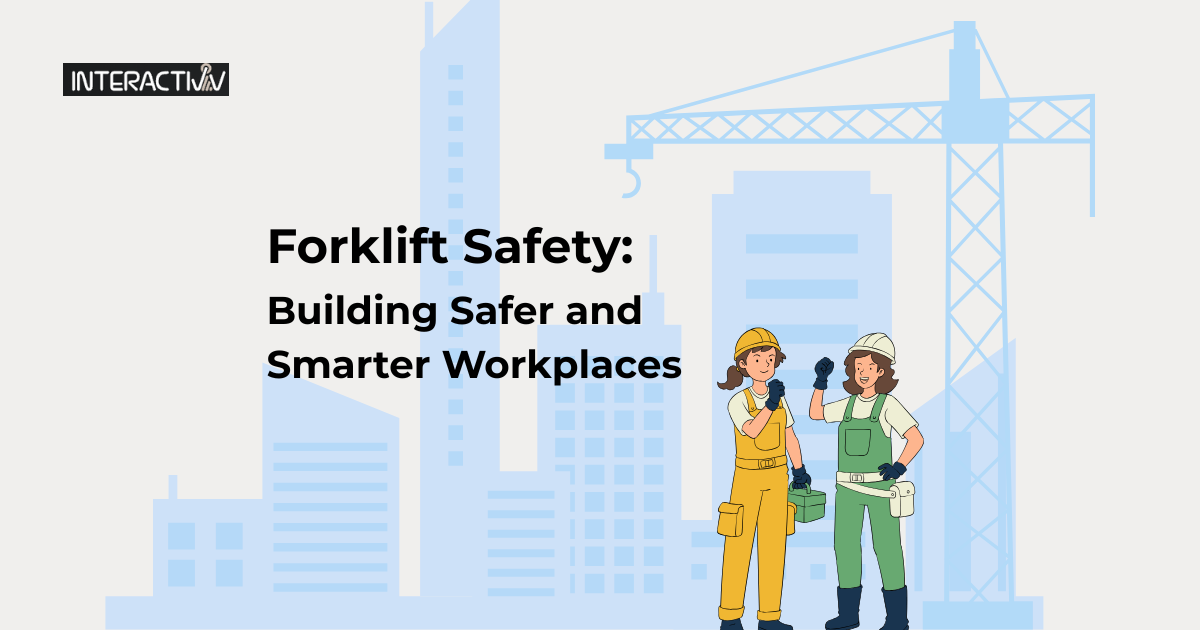Sep 20th, 2025

Forklift Safety are the mainstay of most industries. They transport things fast and effectively whether it is in warehouses and factories or on construction sites and shipping yards. However, as much as forklifts are important, they are accompanied with a great deal of risk. These powerful machines may be responsible of accidents, injuries, damage, and expensive downtime unless the appropriate precautions are taken. This is the reason why forklift safety should not be perceived as a mere form of compliance. It must be a team commitment and embedded in daily practices. Making safety a part of the workplace culture does not only help to protect people, but also increases productivity and develop trust.
In this case, we will simply mention why forklift safety matters, identify the main safety habits, and establish how learning materials like a safety animation video and site induction videocan transform the manner in which personnel learn and implement safety habits.
The forklifts can hoist several heavy loads of thousands of pounds, maneuver in tight areas, and operate effectively in highly congested areas. Huge responsibility comes with that much power. World safety agencies figures highlight that forklift injuries are one of the most common causes of injuries in the workplace in the industry.
Unsafe forklift handling is dangerous:
Investing in the proper safety management, the firms can prevent accidents and decrease risks and create the environment in which the staff will be secure and confident.
Riding on the forklift should never be a practice that any operator tries. That is in the loads, balance, responsive operating procedures, and emergency cases. Effective training does not simply exist in between the pages of the textbook, it must be memorable and captivating. More and more companies are utilizing visual learning tools such as the site induction film in order that the employees that are new to the company know about the dangers during the very first day of employment.
The operators must also have their forklift inspected before starting any sort of job. Checking brakes, steering, tires, audible signals of warning and hydraulic systems are major points. The defects are spotted in time, avoiding subsequent accidents. A small defect that is not detected, but even so minor can cause huge problems.
Each forklift has a maximum capacity and it should be observed. Excessive cargo loading or a wrong balance result in the risk of tip-overs. Operators are also supposed to load materials correctly and then move them without necessarily making jerks or sharp turns.
Forklifts would oftentimes manoeuvre in busy environments where people, pallets, and other machinery are at any rate. They need to be observant, with a clear field of view and need to slow down via blind spots. They are also carrying horns and mirrors to avoid hitting the roads.
However, safety is not simply dependent on the forklift operator. Supervisors, co-workers, and spotters are to be on the alert. Significant signals, walkways, and free communication are a long way to preventing mishaps.
Only a few people will probably read written manuals, whereas computer-based products are attention grabbing. An animation safety video, e.g., includes real-life forklift scenarios, e.g., tipping, blind corner collision, etc., so that the worker can view and recollect the information. During the toolbox talks, training refreshers, and safety campaigns, videos can be replayed.
Regulations cannot be relied upon. The only difference is to make an organization where the issue of safety concerns everybody- whether operator or managers. That means:
When safety is in the DNA of the company, second nature simply happens to all the companies on the site.
Other firms fear spending money in training courses as they are so expensive or time consuming. Such situation, however, is much further away. Safety measures that work are far more expensive to companies in the long term.
The investment to the future of the company is safety investment.
The modern industry cannot live without I have Forklifts which must, however, be approached cautiously. Operators, managers, as well as the laborers, must all be involved so that the work environment can be safe. Considerable training, inspection, monitoring the load limit, and awareness of the area would greatly decrease the accidents.
Use of new technologies like site induction and safety animation videos makes the training interactive and productive in that the worker learns efficiently what he or she should do in order to be safe. These tools can be used in conjunction with good safety management procedures to offer an environment where people are covered, the workplace is productive, and injuries are not the order of the day. It is about its safety and compliance, however, it is about people, it is about resources, and making better tomorrows to all its stakeholders.
Forklift Safety are the mainstay of most industries. They transport things fast and effectively whether it is in warehouses and factories or on construction sites and shipping yards. However, as much as forklifts are important, they are accompanied with a great deal of risk. These powerful machines may be responsible of accidents, injuries, damage, and […]
Fill out the form below and we will send you a quote today…
Copyright © 2025 Interactivv.com. All rights reserved.